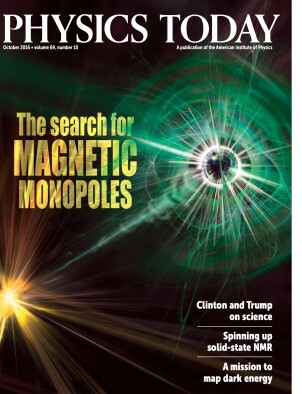Aurora in a bottle
DOI: 10.1063/PT.3.3340
The solar wind fuels the aurora borealis and aurora australis, also known as the northern and southern lights. The solar wind consists of plasma that is released at supersonic speed from the Sun’s upper atmosphere and escapes the Sun’s gravity. As the energetic particles approach Earth, some can become entrained by the planet’s magnetic field. When they slam into the atmosphere, mesmerizing plasma dynamics ensue, most commonly observable at high latitudes.
One can simulate the solar wind’s deflection around Earth in a tabletop lab experiment; all that’s needed are a plasma source that can launch plasma packets at supersonic velocities, a dielectric sphere swathed in a magnetic field, and an enclosure that can maintain a partial vacuum. Mounir Laroussi and colleagues at Old Dominion University’s Applied Plasma Technology Laboratory have carried out such experiments using a plasma pencil, a device they developed that can emit supersonic low-temperature plasma bullets. The plasma travels at velocities up to 100 km/s, usually along a narrow channel through helium or argon gas. Whereas particles in the solar wind have energies of several keV, the energies in the lab are no more than a few eV for electrons and even less for the plasma ions.
As “Earth,” the researchers used a foam ball, 12 cm in diameter, with a small, 100 G bar magnet in its center; they placed the ball in the middle of a glass chamber evacuated to 30–40 torr. Just as Earth’s magnetic field deflects most of the solar-wind particles, the field around the model Earth deflects the incoming plasma packets, as seen here. Although many of the specifics differ—the ball, for instance, isn’t spinning—the plasma never touches the ball’s surface. (M. Laroussi, M. A. Akman, IEEE Trans. Plasma Sci. 42, 2662, 2014, doi:10.1109/TPS.2014.2326559

To submit candidate images for Back Scatter visit http://contact.physicstoday.org
